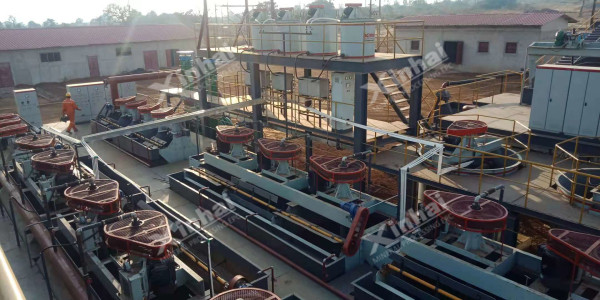The separation of pyrite and arsenopyrite is of great significance for the treatment of gold bearing arsenic sulfide ores. The separation principle is based on the selective effect of some reagents such as lime, copper sulfate, inorganic oxidant, ammonium chloride, organic inhibitor and carbonate on the two minerals.
① Copper sulfate is used to activate arsenopyrite, which is preferentially selected as foam product in lime medium, while pyrite remains in the tank;
② Add enough ammonium chloride into lime medium to suppress arsenopyrite and float pyrite;
③ Using inorganic oxidant or blowing oxygen into the ore slurry to suppress arsenopyrite and float pyrite;
④ Organic inhibitor is used to selectively inhibit arsenopyrite and flotation pyrite;
⑤ Pyrite is selectively activated by carbonate to realize separation of arsenopyrite.
The test shows that the effect is better if sodium sulfide is treated in advance, then the sodium sulfide is completely removed, then ammonia is injected, and then permanganate or pyrolusite is used to oxidize arsenopyrite.

There are many kinds of inorganic oxidants, such as oxygen, potassium permanganate, hydrogen peroxide, manganese dioxide, bleaching powder, potassium persulfate, sodium hypochlorite, potassium dichromate, etc. It is generally believed that the floatability difference between arsenopyrite and pyrite increases and the floatability of arsenopyrite decreases when oxidant is added to the flotation operation. The role of oxidants is that they help to form smectite (FeAsO4 · 2H2O) on the surface of arsenopyrite, thus inhibiting arsenopyrite. It is also believed that arsenopyrite is more easily oxidized than gold bearing pyrite in the presence of oxidant and alkali, and the oxidation degree, oxidation rate and oxidation products are different.
Organic inhibitors, such as dextrin, aniline dyes, ammonium (sodium) humate, tannin, polyacrylamide, lignosulfonate and their mixtures, have been used in the flotation of gold ores and have achieved satisfactory results.
The carbonate method includes sodium carbonate and zinc carbonate. Sodium carbonate has a certain cleaning effect (dissolution) on the oxidation products on the surface of pyrite, thus activating pyrite, increasing the floatability difference between pyrite and arsenopyrite, and strengthening the separation effect. When sodium carbonate and bleaching powder are used in combination, the inhibition of arsenopyrite can be strengthened, and the flotation of pyrite can be improved by controlling the dosing sequence of reagents. When sodium carbonate is used as an adjusting agent, attention should be paid to its dosage. Excessive dosage will also cause inhibition of gold. For the flotation of oxidized ore, when it is required to float at a high pH value, the effect of sodium carbonate is generally better than that of lime. When the pH value of the medium reaches about 9, the soluble iron salt will precipitate.